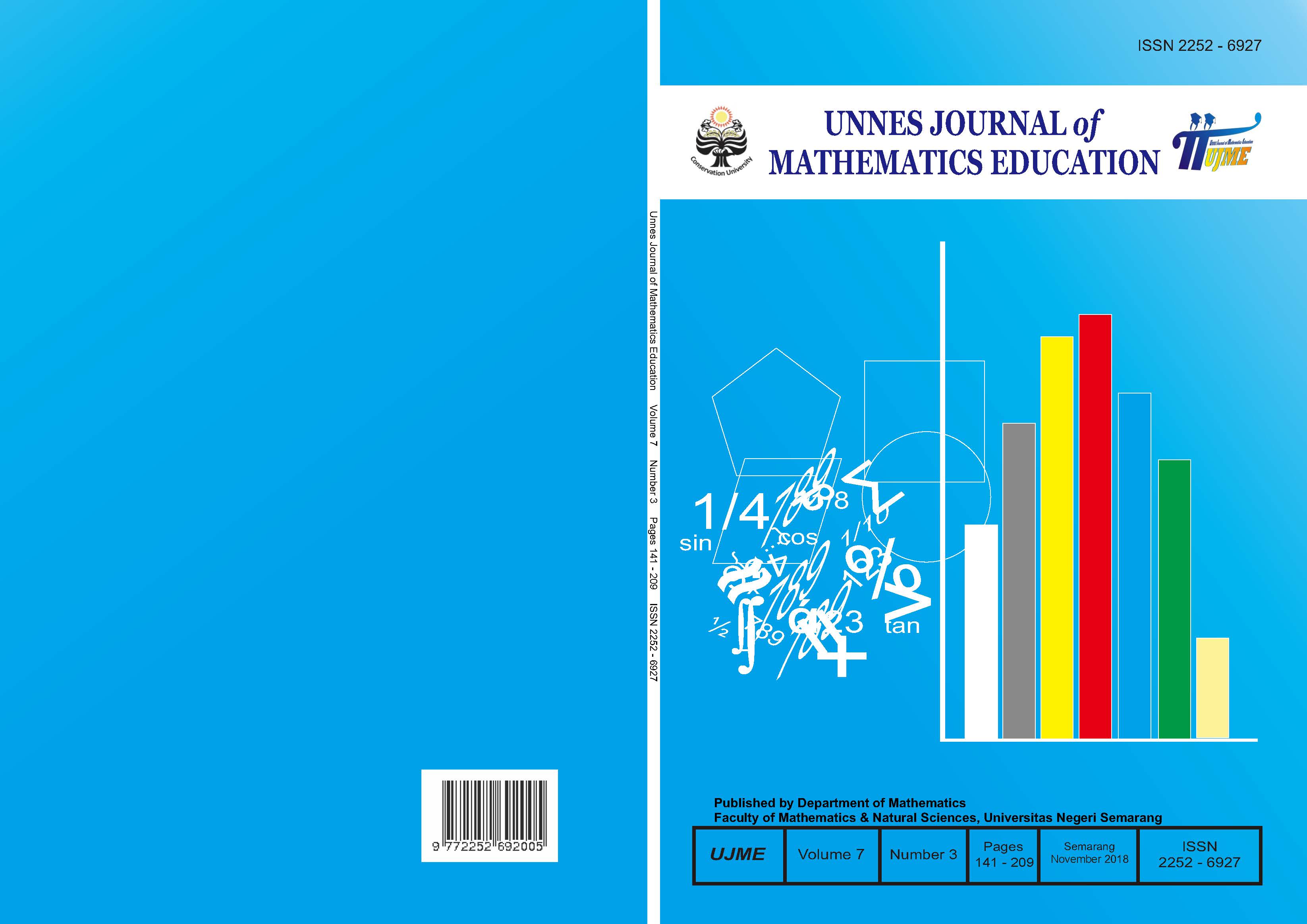Mathematics literacy on creative problem solving with realistic mathematics education approach assisted by e-learning schoology
##plugins.themes.academic_pro.article.main##
Abstract
This research was conducted to find out the influence of Creative Problem Solving (CPS) model of learning with RME approach with the help of Schoology to increase junior high school students’ mathematic literacy and students’ learning output. This research used design true experimental design pretest-posttest control group design. This research used qualitative research method which involved control group and experiment group. The sampling technique used was random sampling. Experiment class was given a treatment in the form of Creative Problem Solving-RME learning. Meanwhile, control group was given a treatment in the form of expository-scientific. The data was collected using mathematic literacy’s ability test, observation, and interview. From the final data of mathematic literacy’s ability test, the researcher analysed and obtained that: (1) the students’ proportion in Creative Problem Solving-RME learning which passed the minimun criteria of mastery learning (KKM) was about 75%; (2) the average of students’ mathematic literacy on Creative Problem Solving- RME learning was better than the average of students’ mathematic litaracy on expository learning. So, we can conclude that Creative Problem Solving-RME learning was effective to improve students’ mathematic literacy.
##plugins.themes.academic_pro.article.details##
References
Cahyono, A.N. (2008). Pengembangan Model Creative Problem Solving Berbasis Teknologi dalam Pembelajaran Matematika di SMA Ibu Kartini Semarang Kelas X Semester Genap Tahun Pelajaran 2006/2007. Tesis. Program Pascasarjana Universitas Negeri Semarang
Dewi, N.R. 2007. Pengembangan Perangkat Pembelajaran Matematika Dengan Topik Teorema Phytagoras Yang Berdasar Pada Model Pembelajaran Creative Problem Solving. Tesis. Program Pascasarjana Universitas Negeri Semarang
Gunes, Ibrahim, Z.O.Gunes, Y.Dereliought, & F.G Kurbaslar. 2015. Relations between operational chemistry and physics problems solving skills and mathemaics literacy self-efficiacy of engineering faculty students. Procedia-Social and Behavioral sciences 174 (2015) 457- 463
Kramarski, B. & Mizrachi, N. 2004. “Enhancing mathematical Literacy With The Use Of Metacognitive Guidance In Forum Discusionâ€. Proceeings of the 28th Conference of the International Group for the Pscyology of Mathematics Education, Vol.3, No.2, p. 169-176.
Malihatul, A. & Hawa. 2014. Anaisis kemampuan siswa Menyelesaikan Soal Matematika Bertipe Pisa. Seminar Nasional Evaluasi Pendidikan tahun 2014.
Mania, S & Nur Indah. 2016. Peningkatan kemampuan Literasi Matematika Siswa Melalui Penerapan Model Pembelajaran PBL di Kelas VII SMP Negeri 5 Pallangga Kabupaten GOWA. Jurnal Matematika dan Pembelajaran. Vol 4 No 2; 2016 ISSN: 2354-6883; e-ISSN: 2581-172X
Mitra Ikhtiar. (2013).Creative Preblem Solving.Tersedia di: http://mitraikhtiar.blogspot.co,id/2013/03/ creative-problem-solving-cps.html?m=1
Murtiyasa, B. 2015. Tantangan Pembelajaran Matematika Era Global Prosiding Seminar Nasional Matematika dan Pendidikan Matematika UMS.
OECD. (2016). PISA 2015 results excellence and equity in education (Volume I). Paris: OECD Publishing.
Ojose, B. 2011. Mathematics literacy: Are We Able to Put the Mathematics We Learn Into Everyday Use? Journal Of Mathematic Education, Vol.4 No.1, 89-100.
Pepkin, K.L. 2004. Creative Problem Solving in Math. Tersedia http://www.uh.edu/honors/Programs-Minors/honors-and-theschool/houstan-teachers-institute/curriculumunits/pdfs/2000/articulating-the-creative-experience/pepkin-00creativity.pdf [diakses 28 Desember 2017].
Sinambela. 2008. Faktor-faktor Penentu keefektifan Pembelajaran dalam Model Pembelajaran Berdasarkan Masalah (Problem Based Instruction), GENERASI KAMPUS, Volume 1, Nomor 2, September 2008. Hal 74-85.
Soviawati, Evi. 2011. Pendekatan Matematika Realistik (PMR) untuk Meningkatkan Kemampuan Berpikir Siswa di Tingkat Sekolah Dasar. Jurnal Matematika Edisi Khusus No. 2. ISSN 1412-565X
Stacey, K. 2011. “ The PISA view of Mathematical Literacy in Indonesiaâ€. IndoMS.J.M.E Vol.2 No.2 July 2011, pp. 95-126.
Sudjana. 2005. Metoda Statistika. Bandung: Tarsito
Sugiyono. 2010. Metode Penelitian Kuantitatif Kualitati dan R & D. Bandung: Alfabeta.
Suharsimi, A. 2013. Dasar-dasar Evaluasi Pendidikan. Jakarta: Bumi Aksara.
Sumandya, Suharta, & Suweken. 2013. Pengembangan Pembelajaran Geometri Dimensi Tiga Berwawasan Pendidikan Matematika Realistik Berorientasi Blended learning dalam upaya Meningkatkan Aktivitas dan Hasil Belajar Matematika Siswa Kelas XI SMK. E-Journal Program Pascasarjana Universitas Pendidikan Ganesha, 2 Singaraja: Program Pascasarjana Universitas Pendidikan Ganesha.
Susilo, J. 2009. Pengembangan Perangkat Pembelajaran Dengan Strategi TTW melalui Model CPS Untuk Meningkatkan Komunikasi Matematis Materi segi Empat. Tesis. Program Pascasarjana Universitas Negeri Semarang
Thomson, Sue. Kylie Hilman, & Lisa de bortoli. 2013. A teacher Guide to PISA Mathematical Literacy. Australia: ACER Press. (Online).
Usdiyana et al. 2009. Meningkatkan Kemampuan Berpikir Logis Siswa Smp melalui Pembelajaran Matematika Realistik. Jurnal pengajaran MIPA, Vol 13 No 1 April 2009. ISSN: 1412-0917
Wardono, B.J Kusuma, E.R Winarti. 2016. Kemampuan Literasi Matematika Peserta Didik Kelas VIII pada Pembelajaran Realistik Berbantuan Edmodo. Journal Pendidikan Matematika. Vol. 5 No. 3 (2016). ISSN 2460-5840.
Wardono and Masjaya. 2018. Pentingnya Kemampuan Literasi Matematika untuk Menumbuhkan Kemampuan Koneksi Matematika dalam Meningkatkan SDM. Prisma: Seminar Nasional Pendidikan Matematika. Vol.1 (2018).
Wardono and Scolastika mariani. 2015. Implementasi Model PBL Dengan Pendekatan Realistik Berbantuan Edmodo Untuk Meningkatkan Literasi Matematika Siswa Kelas VII. Journal Pendidikan Matematika.Vol 4 No.2 (2015). ISSN 2460-5840
Wardono, S.B Waluyo, S. Mariani, & Candra D. 2016. Mathematics Literacy on Problem Based Learning with Indonesian Realistic Mathematics Education Approach Assisted E-Learning Edmodo. Journal of Physics: Conference Series
Wardono and Scolastika mariani. 2014. The realistic learning model with Character Education And PISA Assement To Improve Mathematic Literacy. International Journal of Education and Research. Vol. 2 No. 7 July 2014. ISSN: 2201-6740.
Wardono, S. Mariani, P. Hendikawati, & Ikayani. 2017. Mathematizing Process of Junior High School Students to Improve Mathematics Literacy Refers PISA on RCP Learning. Journal of Physics: Conference Series
Wardono and Scolastika mariani. 2018. The analysis of mathematics literacy on PMRI learning with media schoology of junior high school students. Journal of Physics: Conference Series
Wardono, B Waluya , Kartono , Mulyono and S Mariani. 2017. Development of innovative problem based learning model with PMRI-scientific approach using ICT to increase mathematics literacy and independence-character of junior high school students. Journal of Physics: Conference Series
Wardono ,C Setiani, & S B Waluya. 2018. Analysis of mathematical literacy ability based on self-efficacy in model eliciting activities using metaphorical thinking approach. Journal of Physics: Conference Series
Wardono et al. 2017. Analysis of Mathematical Literacy on Realistic Problem-Based Learning with E-Edmodo Based on Student’s Self Effecacy. Journal of Primary Education 6 (2) (2017) : 103-113
Wardono et al. 2015. The Realistic Scientific Humanist Learning With Character Education To Improve Mathematics Literacy Based on PISA. International Journal of Education and Research. Vol. 3 No. 1 January 2015. ISSN: 2201-6740.
